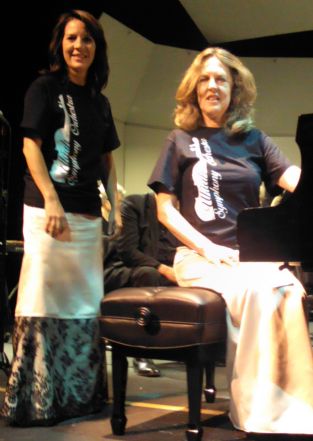|
Symphony
SRS SEASON ENDS WITH RESOUNDING TA-TA-TA-BANG
by Terry McNeill
Sunday, June 1, 2025
Symphony
YOUTHFUL VIRTUOSITY ON DISPLAY AT USO'S MAY CONCERTS
by Peter Lert
Saturday, May 17, 2025
Symphony
MYSTICAL PLANETS AND LIVELY GERSHWIN ORTIZ AT FINAL SRS CONCERT
by Peter Lert
Sunday, May 4, 2025
Symphony
VSO'S CONCERT MUSIC OF TIME, MUSIC OF PLACE
by Peter Lert
Sunday, April 27, 2025
Choral and Vocal
VOCAL ELEGANCE AND FIRE AT THE 222'S RECITAL APRIL 26
by Pamela Hicks Gailey
Saturday, April 26, 2025
CANTIAMO SONOMA SINGS AN INSPIRED GOOD FRIDAY MOZART REQUIEM CONCERT
by Pamela Hicks Gailey
Friday, April 18, 2025
DRAMATIC SHOSTAKOVICH SYMPHONY CLOSES PHILHARMONIC'S 25TH SEASON
by Terry McNeill
Sunday, April 13, 2025
LARGE COLLEGE OF MARIN AUDIENCE GREETS STOPHER ARTISTRY
by Terry McNeill
Saturday, April 5, 2025
Chamber
FRISSON DELIVERS SHIVERS OF DELIGHT
by Abby Wasserman
Sunday, March 30, 2025
OLD AND MOSTLY NEW IN SRS MARCH CONCERT IN WEILL
by Peter Lert
Saturday, March 22, 2025
|
 |
 Pianists E. Casanova and E. MacDougall Dec. 8 |
MOZART AND ST.SAËNS WORKS IN USO CHRISTMAS CONCERT
by Earl Dixon
Sunday, December 8, 2013
The Ukiah Symphony Orchestra presented its holiday program December 7 and 8 at the Mendocino College Center Theater. Pianists Elena Casanova and Elizabeth McDougall were featured guest artists.
At the Sunday matinee conductor Les Pfutzenreuter announced a few changes in the order of the program and then started with “A Canadian Brass Christmas,” arranged by Luther Henderson and Calvin Custer.
This medley featured symphonic arrangements of four carols: “Ding Dong Merrily on High,” “I Saw Three Ships,” “Huron Carol” and “Here We Come A-Wassailing.” Although some of the attacks by the horn section seemed underpowered, the pieces were rendered with feeling and good dynamic control. The lesser-known “Huron Carol” was an inspiration.
Next came “Russian Christmas Music” by the prolific American composer Alfred Reed. This piece begins with a rather melancholy theme and then gradually builds to grandeur. Mr. Pfutzenreuter skillfully led the orchestra through the slow transition, marked thematically by chordal variations rather than melodic ones. This is a difficult movement that the symphony carried off successfully to a triumphant conclusion, helped in no small part by some excellent percussion playing.
Following Intermission Ms. Casanova and Ms. McDougall took their places at facing pianos on stage, and the Orchestra began with Mozart’s Concerto in E-Flat Major, K. 365. This piece has three movements: Allegro, Andante, and Rondo. It was unfortunate in this splendid Concerto that Ms. Casanova performed on a concert grand, with its more powerful and brighter sound, and Ms. MacDougall played Mozart’s magical themes on a less resonant smaller grand. This may have contributed to the impression that Ms. McDougall seemed to struggle for several moments, an uncharacteristic result for this stalwart Mendocino artist. Aside from those brief moments her performance was as always technically brilliant. Unhampered by technical pitfalls, Ms. Casanova turned in a flawless performance and seemed to exhibit a real joy in what she was doing.
The first movement exuded a sense of playfulness among the two pianists and the Orchestra that communicated well to the audience.
The Andante featured some impressive handoffs in individual passages between the two soloists. Despite the differing tonal quality of the two pianos, these alternating thematic phrases were handled with such skill that it was difficult to tell where one left off and the other began.
The Rondo was crisp and exciting but the conclusion of the Concerto was played by the orchestra in an understated manner. Just why this happened is difficult to pinpoint, but the final chord was performed with such timidity that the audience was uncertain as to whether the piece had ended or not, and so sat in silence for an uncomfortably long moment.
The final formal work on the program was St. Saëns’ 14-movement suite “Carnival of the Animals” from 1886. This was played to an amusing poetic narration written for the piece in 1949 by Ogden Nash and read by Ukiah thespian Phyllis Bluestein. This was expertly played and coordinated by all concerned. One of the composition’s iconic pieces, “Aquarium,” was especially poignant.
The afternoon concluded with a Christmas sing-along of several traditional carols played by the Orchestra and the two pianists.
|

